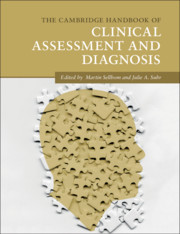Book contents
- The Cambridge Handbook of Clinical Assessment and Diagnosis
- The Cambridge Handbook of Clinical Assessment and Diagnosis
- Copyright page
- Contents
- Figures
- Tables
- Contributors
- Acknowledgments
- 1 Introduction to the Handbook of Clinical Assessment and Diagnosis
- Part I General Issues in Clinical Assessment and Diagnosis
- Part II Specific Clinical Assessment Methods
- Part III Assessment and Diagnosis of Specific Mental Disorders
- 21 Assessment of Childhood Neurodevelopmental Disorders
- 22 Assessment of Childhood Disruptive Behavior Disorders and Attention-Deficit/Hyperactivity Disorder
- 23 Assessment of Depressive Disorders and Suicidality
- 24 Assessment of Anxiety Disorders and Obsessive-Compulsive Disorder
- 25 Assessment of Trauma- and Stressor-Related Disorders
- 26 Assessment of People with Psychotic and Bipolar Disorders
- 27 Assessment of Eating Disorders
- 28 Assessment of Substance Use Disorders
- 29 Assessment of Personality Disorder
- 30 Neuropsychological Assessment of Dementia
- 31 Assessment of Traumatic Brain Injuries
- Part IV Clinical Assessment in Specific Settings
- Index
- References
31 - Assessment of Traumatic Brain Injuries
from Part III - Assessment and Diagnosis of Specific Mental Disorders
Published online by Cambridge University Press: 06 December 2019
- The Cambridge Handbook of Clinical Assessment and Diagnosis
- The Cambridge Handbook of Clinical Assessment and Diagnosis
- Copyright page
- Contents
- Figures
- Tables
- Contributors
- Acknowledgments
- 1 Introduction to the Handbook of Clinical Assessment and Diagnosis
- Part I General Issues in Clinical Assessment and Diagnosis
- Part II Specific Clinical Assessment Methods
- Part III Assessment and Diagnosis of Specific Mental Disorders
- 21 Assessment of Childhood Neurodevelopmental Disorders
- 22 Assessment of Childhood Disruptive Behavior Disorders and Attention-Deficit/Hyperactivity Disorder
- 23 Assessment of Depressive Disorders and Suicidality
- 24 Assessment of Anxiety Disorders and Obsessive-Compulsive Disorder
- 25 Assessment of Trauma- and Stressor-Related Disorders
- 26 Assessment of People with Psychotic and Bipolar Disorders
- 27 Assessment of Eating Disorders
- 28 Assessment of Substance Use Disorders
- 29 Assessment of Personality Disorder
- 30 Neuropsychological Assessment of Dementia
- 31 Assessment of Traumatic Brain Injuries
- Part IV Clinical Assessment in Specific Settings
- Index
- References
Summary
Traumatic brain injury is one of the most prevalent neurological disorders and has gained public attention in recent years. Depending on several factors, including level of consciousness, post-traumatic amnesia, and neuroimaging findings, brain injuries are classified as mild, moderate, or severe. Individuals with moderate to severe injuries have worse cognitive, emotional, and functional outcomes and exhibit a more prolonged recovery than those with mild injuries. Although mild injuries are usually associated with short-term cognitive and emotional difficulties that resolve within weeks, sometimes symptoms persist longer than three months. These prolonged or post-concussion syndrome symptoms are not related to the injury itself but rather are influenced by prior and current psychological symptoms. As individuals with varying levels of brain injury progress through acute, subacute, and chronic stages of their recovery, neuropsychological evaluations are used to assess cognitive and emotional functioning, predict outcomes, and provide treatment recommendations.
Keywords
- Type
- Chapter
- Information
- The Cambridge Handbook of Clinical Assessment and Diagnosis , pp. 431 - 444Publisher: Cambridge University PressPrint publication year: 2019



